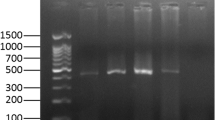Abstract
Lumpy skin disease virus (LSDV) is the causative agent of lumpy skin disease (LSD) which is a member of Capripoxvirus. It is an economically critical transboundary disease affecting cattle. This study records an LSD outbreak in Ganjam district of Odisha, India during August 2020. The epidemiological data were analysed and LSDV was genetically characterized. Out of the 452 animals clinically examined (59 farms), 63 animals were clinically affected with LSD, with a total morbidity rate of 13.93%. The morbidity rates in the surveyed villages (n = 10) varied from 5.55 to 21.62%. The multivariable logistic regression analysis showed that grazing of animals (P = 0.013; OR: 2.04; 95% CI: 1.16–3.57) and age of cows > 3 years old (P = 0.001; OR: 2.90; 95% CI: 1.65- 5.07) were potential risk factors for the presence of LSD. Out of the 53 clinically suspected animals’ samples, 18 samples (33.96%) were found positive for both the P32 and F genes of Capripoxvirus by PCR. Phylogenetic analysis of the P32 gene of LSDV (MW147486) showed 100% similarity with other isolates from India, Bangladesh, Egypt and Saudi Arabia. Additionally, phylogenetic analysis of the F gene of LSDV (MW147485) revealed a similarity of 97.99%, with Odisha India (MT074110) isolate and located in the same cluster with other Indian isolates.







Similar content being viewed by others
Data availability
Data is available within the article to support the findings of this study.
Code availability
Not applicable.
References
Abera Z, Degefu H, Gari G, Ayana Z (2015) Review on epidemiology and economic importance of lumpy skin disease. Int J Basic Appl Virol 4:08–21
Abutarbush S, Ababneh M, Al Zoubi I, Al Sheyab O, Al Zoubi M, Alekish M (2015) Lumpy skin disease in Jordan: Disease emergence, clinical signs, complications and preliminary-associated economic losses. Transbound Emerg Dis 62(5):549–554
Ahmed W, Kawther S (2008) Observations on lumpy skin disease in local Egyptian cows with emphasis on its impact on ovarian function. Afr J Microbiol Res 2:252–257
Albayrak H, Ozan EM, Kadi H, Cavunt A, Tamer C, Tutuncu M (2018) Molecular detection and seasonal distribution of lumpy skin disease virus in cattle breeds in Turkey. Med Weter 74(03)
Allam AM, Elbayoumy MK, Abdel-Rahman EH, Hegazi AG, Farag TK (2020) Molecular characterization of the 2018 outbreak of lumpy skin disease in cattle in Upper Egypt. Vet World 13(7):1262
Al-Salihi K (2014) Lumpy skin disease: Review of literature. Mirror Res Vet Sci Anim 3:6–23
Ambilo A, Melaku A (2013) Major skin diseases of cattle: prevalence and risk factors in and around Hawassa. Southern Ethiopia J Adv Vet Res 3(4):147–153
Ayelet G, Haftu R, Jemberie S, Belay A, Gelaye E, Sibhat B (2014) Lumpy skin disease in cattle in central Ethiopia: Outbreak investigation and isolation and molecular detection of the virus. Revue Scientifique Et Technique (international Office of Epizootics) 33:877–887
Babiuk S, Bowden T, Boyle D, Wallace D, Kitching RP (2008) Capripoxvirus: an emerging worldwide threat to sheep goats and cattle. Transbound Emerg Dis 55:263–272
Carn VM, Kitching RP (1995) An investigation of possible routes of transmission of lumpy skin disease virus (Neethling). Epidemiol Infect 114(1):219–226
Chihota CM, Rennie LF, Kitching RP, Mellor PS (2001) Mechanical transmission of lumpy skin disease virus by Aedes aegypti (Diptera: Culicidae). Epidemiol Infect J 126(2):317–321
Constable PD, Hinchcliff KW, Done SH, Grundberg W (2017) Veterinary Medicine: A Textbook of the diseases of cattle, horses, sheep, pigs, and goats, 11th edn. Elsevier, London, p 1591
Davies FG (1991) Lumpy skin disease, an African Capripoxvirus disease of cattle. Br Vet J 147(6):489–503
DAHD (2019) Provisional key results of 20th livestock census, Department of Animal Husbandry & Dairying. http://dahd.nic.in/division/provisional-key-results-20th-livestock-census
Dehuri M, Panda MR, Mohanty B, Hembram A, Mahapatra T, Sahu A (2017) Ixodid ticks infesting cattle and associated risk factors in coastal districts of Odisha. J Entomol Zool Stud 5(4):129–132
Doğan F, Dağalp SB, Ataseven VS, Farzani TA (2016) The molecular detection of lumpy skin disease virus from infected cattle in turkey. J Appl Bio Sci 10(2):01–03
Elhaig MM, Selim A, Mahmoud M (2017) Lumpy skin disease in cattle: Frequency of occurrence in a dairy farm and a preliminary assessment of its possible impact on Egyptian buffaloes. Onderstepoort J Vet Res 84(1):1–6
Gari G, Waret-Szkuta A, Grosbois V, Jacquiet P, Roger F (2010) Risk factors associated with observed clinical lumpy skin disease in Ethiopia. Epidemiol Infect J 138:1657–1666
Gurav YK, Raut CG, Yadav PD, Tandale BV, Sivaram A, Pore MD, Basu A, Mourya DT, Mishra AC (2011) Buffalopox outbreak in humans and animals in Western Maharashtra. India Prev Vet Med 100(3–4):242–247
Hailu B, Tolosa T, Gari G, Teklue T, Beyene B (2014) Estimated prevalence and risk factors associated with clinical Lumpy skin disease in north-eastern Ethiopia. Prev Vet Med 115(1–2):64–68
Ireland DC, Binepal YS (1998) Improved detection of Capripoxvirus in biopsy samples by PCR. J Virol Methods 74:1–7
Kumar S, Stecher G, Tamura K (2016). MEGA7: molecular evolutionary genetics analysis version 7.0 for bigger datasets. Mol Biol Evol 33(7): 1870–1874
Kurnar SM (2011) An outbreak of lumpy skin disease in a Holstein dairy herd in Oman: a clinical report. Asian J Anim Vet Adv 6(8):851–859
Lefèvre PC, Gourreau JM (2010) Lumpy skin disease. In: Lefèvre PC, Blancou J, Chermette R, Uilenberg G (Eds.) Infectious and parasitic diseases of livestock. OIE - 407
Limon G, Gamawa AA, Ahmed AI, Lyons NA, Beard PM (2020) Epidemiological characteristics and economic impact of lumpy skin disease, sheeppox and goatpox among subsistence farmers in northeast Nigeria. Front Vet Sci 29:7–8
Mafirakureva P, Saidi B, Mbanga J (2017) Incidence and molecular characterisation of lumpy skin disease virus in Zimbabwe using the P32 gene. Trop Anim Health Prod 49(1):47–54
Mulatu E, Feyisa A (2018) Review: Lumpy skin disease. J Vet Sci Tech 9(535):1–8
OIE (2010) Lumpy skin disease. Manual of Diagnostic Tests and Vaccines for Terrestrial Animals. OIE, Paris, pp 1–13
Rao MRK, Padhy RN, Das MK (2015) Surveillance on malaria and dengue vectors fauna across in Angul district of Odisha, India: an approach to determine their diversity and abundance, correlation with the ecosystem. J Entomol Zool Stud 3:459–469
Saitou N, Nei M (1987) The neighbor-joining method: a new method for reconstructing phylogenetic trees. Mol Biol Evol 4:406–425
Salib FA, Osman AH (2011) Incidence of lumpy skin disease among Egyptian cattle in Giza Governorate. Egypt Vet World 4(4):162–167
Sevik M, Dogan M (2017) Epidemiological and molecular studies on lumpy skin disease outbreaks in Turkey during 2014–2015. Transbound Emerg Dis 64:1268–1279
Sudhakar SB, Mishra N, Kalaiyarasu S, Jhade SK, Hemadri D, Sood R, Bal GC, Nayak MK, Pradhan SK, Singh VP (2020) Lumpy skin disease (LSD) outbreaks in cattle in Odisha state, India in August: 2019 Epidemiological features and molecular studies. Transbound Emerg Dis 67(6):2408–2422
Tuppurainen ES, Stoltsz WH, Troskie M, Wallace DB, Oura CA, Mellor PS, Coetzer JA, Venter EH (2011) A potential role for ixodid (hard) tick vectors in the transmission of lumpy skin disease virus in cattle. Transbound Emerg Dis 58(2):93–104
Tuppurainen ES, Oura CAL (2012) Review: Lumpy skin disease: An emerging threat to Europe, the Middle East and Asia. Transbound Emerg Dis 6:243–255
Author information
Authors and Affiliations
Contributions
Santosh Senapati and Manoranjan das conceived and planned the study; Ahmed Selim and Rajesh Sethi collaborated in the writing and revision of the manuscript; Rajesh Sethi and Aditya Prasad Acharya conducted laboratory testing; Ahmed Selim and Chinmoy Mishra collaborated is sequencing of genes and phylogenetic analysis. Santosh Senapati and Shuvranshu Biswal revised the manuscript. Yamen Mohammed Hegazy performed the statistical analysis. All authors' read and endorsed the final manuscript.
Corresponding author
Ethics declarations
Ethics approval
Oral permission and written was taken from owners of the farms before collection of samples. Additionally, samples collection was performed by professional field veterinarians.
Consent to participate
Oral and written permission was taken from owners of the farms before collection of samples. There is no specific law in India which requires permission from the ethics committee for collection of samples for clinical diagnosis. Additionally, samples collection was performed by professional field veterinarians.
Consent for publication
We know of no conflicts of interest associated with this publication. As Corresponding Author, I confirm that the manuscript has been read and approved for submission by all the named authors.
Conflict of interest
The authors of this study stated that they have no conflicts of interest.
Additional information
Publisher's note
Springer Nature remains neutral with regard to jurisdictional claims in published maps and institutional affiliations.
Rights and permissions
About this article
Cite this article
Sethi, R.K., Senapati, S.K., Selim, A.M. et al. Molecular epidemiology of lumpy skin disease outbreak in Odisha, India. Vet Res Commun 46, 711–717 (2022). https://doi.org/10.1007/s11259-022-09886-8
Received:
Accepted:
Published:
Issue Date:
DOI: https://doi.org/10.1007/s11259-022-09886-8




